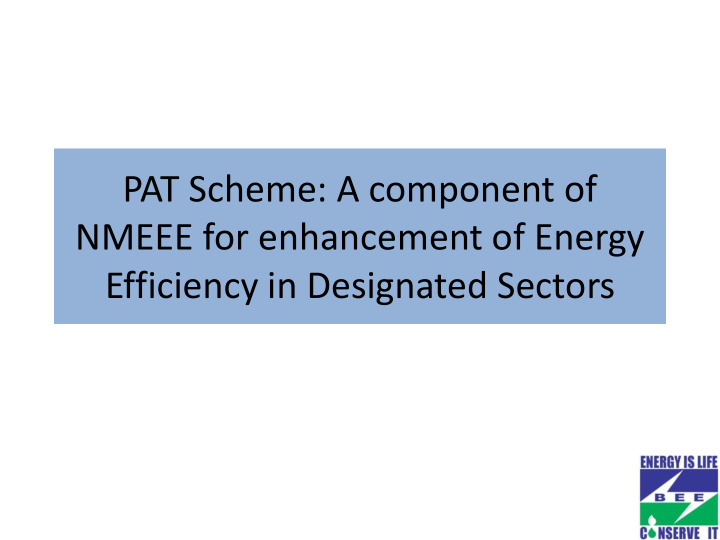



PAT Scheme: A component of NMEEE for enhancement of Energy Efficiency in Designated Sectors SVR 2014
Perform, Achieve and Trade (PAT) – WHY? http://www.footprintnetwork.org • National Action Plan on Climate Change (NAPCC) – Nation Mission for Enhanced Energy Efficiency (NMEEE) Share of cumulative abatement Perform Achieve and Trade (PAT): a between 2010-2035 regulatory instrument to reduce specific Efficiency 51% energy consumption in energy intensive Renewables 32% industries, with an associated market based Biofuels 1% mechanism to enhance the cost effectiveness through certification of excess Nuclear 8% energy saving which can be traded. CCS 8% SVR 2014 WEO, 2010
Energy and Development A minimum energy How much energy is required ? consumption of 2400 kgoe/year/cap is needed today to achieve HDI of 0.9 Countries which “develop” later achieve transition at lower energy levels Probable that transition may occur at 1500 kgoe in the future Enhanced energy efficiency is essential to enable early transition SVR 2014
Indian Textile Industry Indian Textile Industry Textile sector contributes about 14% to the industrial production Textile sector also contributes about 4% to the GDP and 11% to the country’s export earnings The textile sector is the second largest provider of employment after agriculture. The report of the Planning Commission on boosting India’s manufacturing exports during 12th Five Year Plan (2012- 17), envisages India’s exports of Textiles and Clothing at USD 64.11 billion by the end of March 2017 SVR 2014
Textile Sector- Categorization Sr No Sub-Sector Section Major Product Speciality Processing 1 Spinning Ring Frame Yarn @40s Count TFO, Doubling, Open End, Dying 2 Processing Processing Fabric Printing, Finishing 3 Composite Spinning, Fabric Printing, Finishing Weaving, Knitting, Processing 4 Fibre Fibre SVR 2014
Grouping of Textile DCs Textile (90) Spinning Processing Composite Fiber (37) (20) (27) (06) CPP CPP CPP Non Non Non (34) (15) (22) CPP CPP CPP (03) (05) (05) SVR 2014
Product Mix Series Production Parallel Production Section 1 Section 1 Section 1 Section 1 Section 2 Section 2 Section 2 Section 2 Section 3 Section 3 Section 3 Section 3 Product A Product A Product B Product C Major Product A Major Product A Product B Product C Process B1 Process B2 Product C Product B SVR 2014
Product Mix- Intermediary Product Series Production Parallel Production Section 1 Section 1 Section 1 Section 1 Ei E1 Si S1 Ei Pi: Pi: Si Intermediary Section 2 Ee Section 2 Section 2 Section 2 E2 Intermediary Product Se E2 Ee Product S2 Purchased S2 Purchased from market Se from market Section 3 Section 3 Section 3 Section 3 Pe: Intermediary Pe: Intermediary Product Product Sold out to the market Sold out E1 Product A Product A Product B Product C to the market S1 Major Product A (P) E4 S4 E3 S3 Major Product A (P) Product B (P1) Product C (P2) Process B1 Process C E4 E3 S3 S4 Process B2 Notional Energy for Import( E i) = Pi x Si Product C (P2) Notional Energy for Export( E e)=Pe x Se Total Energy (E)= E1+Ei-Ee Product B (P1) SEC for Major Product: S2=E2/P Equivalent Product( P eq) =P+P1 x (S3/S2)+P2*(S4/S2) Si, Se S1,S2,S3,S4 are SEC of Process SEC= E / P eq Pi, Pe, P,P1,P2 are Production Ei,Ee,E1,E2,E3,E4 are Energy SVR 2014
PAT-WHERE? • Reporting Formats – FORM I and Sector Specific Pro forma • Normalization • Integration • Communication • Adoption • Evaluation SVR 2014
PAT – WHEN? Timeline for issuance of ESCerts 1 st April 30 th June 30 th Nov. M&V- 15 Days 10 Working Days 15 Working Days Submission of FORM I, Form A,B, SDA’s Sectoral Scrutiny Proforma … BEEs Scrutiny BEEs recommend ation to Issue of Central ESCerts and Government Trading 10 SVR 2014
Normalization Factors Normalisation is a very important and rational process of modifying energy data in order to account for changes in quantifiable variables that impacts energy performance and static factors to compare energy performance under equivalent conditions There are several factors that need to be taken into consideration in the assessment year such as change in product mix, change in fuel quality, import/export of electricity etc. The undue advantage or disadvantage could not be imposed on a DC while assessing the performance in the assessment year as compared to the baseline year for any change in above factors. SVR 2014
Normalization Factors- Broad Categorization in Textile Plant Product Mix • Environmental Concern (Additional • – Import & Export of Intermediary product Environmental Equipment requirement due to major change in government policy on Value added product – Environment) Major Product(For Series and Parallel – Production) • Biomass/Alternate Fuel Weaving & Knitting Production – Unavailability – Finished Fabric for Composite Sub Group • Construction Phase or Project a) Cotton Activities b) Polyester Cotton c) Lycra Addition of New Line/Unit (In Process & • d) Non Cellulosic Product (100% Synthetic) Power Generation) e) Wool based product • Fuel Quality in CPP Unforeseen Circumstances • Low PLF in CPP • Renewable Energy • • Power Mix (Imported & Exported from/ to the grid and self-generation from the captive power plant) Capacity Utilization • – Start/Stop SVR 2014
Thank you ! SVR 2014
Recommend
More recommend